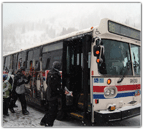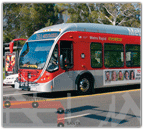Combining students IDs and transit passes
25 May, 2010
category: Contactless, Education, Library, Transit
 The multi-function, multi-app smart card may not be such a mythical beast
The multi-function, multi-app smart card may not be such a mythical beast
Multi-function cards on college campuses aren’t new. Student IDs have paid for meals, accessed residence halls and checked out library books for decades. But adding applications that can be used outside of the university has been more difficult. Off-campus merchant programs are common but beyond that the campus card remains an on-campus tool.
A number of universities have expressed interest, largely due to student demand, in using the card off-campus in the local transit agency’s contactless fare collection system. While campuses have offered students deals on public transportation passes in the past, this has typically involved a separate card or a homegrown solution with a campus card reader on the transit vehicles.
Integration with the existing contactless system is a far more seamless solution, but it has proven to be an elusive goal. The problem is that transit agencies frequently use proprietary systems and specific contactless card types that don’t readily translate to other uses. In other words, if a campus issues a contactless card that meets the transit specs it may not be usable for on campus needs such as access control.
Obviously, the ideal scenario is a standard contactless technology that serves the campus card needs and also supports the transit application. This has not been the case.
In most cities with contactless fare collection systems, a local university would need to buy a specific card from the transit system’s vendor. The campus would then issue this card in its normal manner and use the magnetic stripe for school needs. The transit application could either be pre-loaded on the contactless chip or the student could take it to a specific location to turn-on the functionality.
The process is cumbersome, expensive and virtually eliminates the campus from utilizing contactless technology for its own needs.
New transit systems open door for campus cooperation
The challenges that have kept campus cards and transit cards largely separate are beginning to ease. Fare collection systems are evolving and at the same time campus card programs are recognizing the benefits of contactless technology. The time may be right for cooperation as exemplified by recent projects in Utah and Washington D.C.
The Utah Transit Agency (UTA) approached its fare collection system differently than others in the U.S. It opted to deploy a more open system that accepts multiple card types including its own fare collection cards and bank-issued contactless credit and debit cards.
The UTA system as deployed by ERG Group, now owned by Cubic, and MetraTech, a Boston-based billing and settlement provider. Utah was ERG’s first foray into this type of public transit payment mechanism.
“It’s the first and only one we believe that’s been fully deployed,” says Michael Cook, ERG’s vice president of business development for the Americas. “There are other systems out there that use a credit card, but it’s really a transit application embedded in the card that gives the appearance that someone is using a credit card. We view Utah as our future. It’s similar to what they’re doing in New York, but on the subway it’s a flat fare structure. Here we can accommodate all types of fares.”
Westminster College in Salt Lake City and Utah Valley University in Orem have started using contactless cards for student IDs and enabling the same card to be used as a transit pass. The two schools, however, took different paths to get there.
Utah Valley was already using a multi-technology student ID card, including a Mifare chip and magnetic stripe, says Dawn Bridges, manager of the Campus Connection ID Station at the university. The campus has a Blackboard transaction system and uses Lenel to manage physical access control. The contactless chip is also starting to be used for a time clock system.
Utah Valley and the UTA had worked together previously and when the school found out its ID card could work with the transit system administrators decided to combine them, Bridges says. Students pay $20 a month for the pass and the information stored on the chip is then sent to the UTA. That way when the student taps the card on the reader it’s read as valid. The two are also working on a system that would enable real-time connectivity.
Westminster College took a different approach when combining its student ID and transit pass. The school had not been using a contactless card but decided to make the switch after discussions with the UTA, says Kerry Case, director of the environmental center at Westminster. “It’s nicer to have only to carry around one card instead of two,” she says. “With the old passed you had to show your student ID card with the transit pass if the transit police asked.”
The school is now buying blank card stock from the UTA to use as its student ID, Case says. Since the UTA buys card stock in bulk it’s cheaper than Westminster buying it on its own. The card also has a magnetic stripe that is used for food service, access to the gym and other applications. Westminster has an in-house system for managing the campus card program for its 2,500 students.
The primary purpose of the contactless portion of the card is for the transit pass, says Collin Bunker, director of information services at Westminster. When the card is issued the number on the chip is sent to the UTA and updates are sent on a weekly basis. Students don’t have to pay for the pass as long as they use the system a certain number of times a month.
But with contactless cards starting to be issued throughout campus the college is rolling out additional functionality, Bunker says. Westminster is putting contactless physical access control readers in its new science building to enable student access to the labs after hours. He says the school is considering expanding the contactless physical access control system over time to other buildings and is also exploring its use for meal plans as well.
American University in Washington is conducting a pilot combining its student IDs with the Washington Metropolitan Area Transit Authority, according to a university spokesperson.
A small number of American University student IDs with the transit agency’s contactless SmarTrip functionality are being tested by selected members of the campus community. If all goes well and the test is successful, then the entire American University community may soon be offered the option to integrate their student ID with SmarTrip access.
Whereas the UTA used the ISO 14443 contactless smart card standard for its cards, SmarTrip uses a proprietary technology that can only be purchased from the system vendor. This would also make it difficult to use the card for anything other than the transit program.
For several years, however, rumor that the Washington D.C. transit program would migrate from the proprietary card to a more standard card type has circulated. If this was the case, American University could one day issue the combined card and open up the use of the contactless chip for on-campus applications.
A dual-use future?
As contactless smart cards become more popular on campus its possible there may be more integration like those in Utah and Washington D.C. For this to happen on a large scale, however, changes are still required.
Transportation officials will have to decide if using a proprietary, closed-loop system is better than a more inclusive, open fare collection system. Unless this move to card types that readily support campus applications occurs, campus card administrators will need to weigh the relative importance of the transit application compared to the other on-campus applications of contactless technology.




